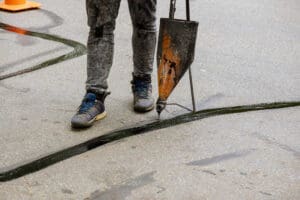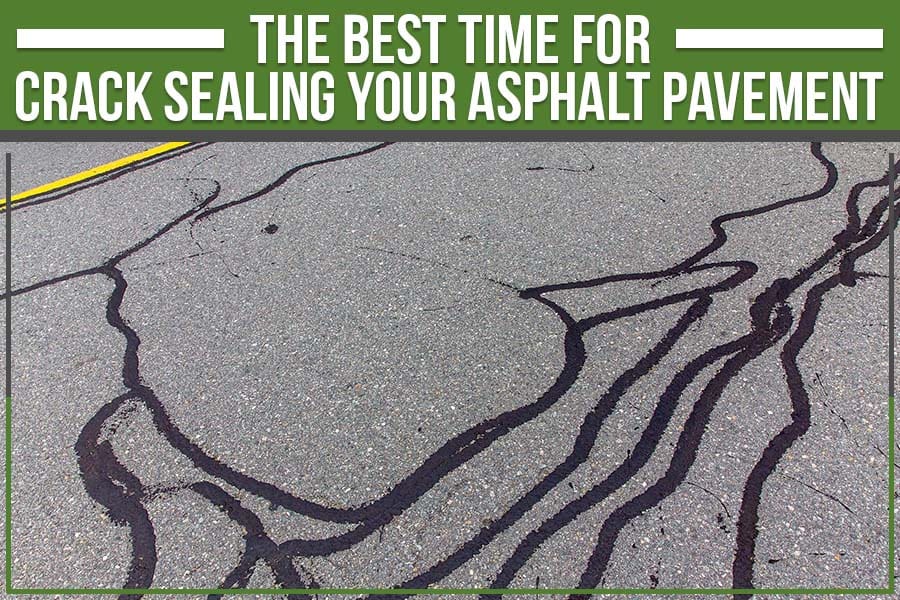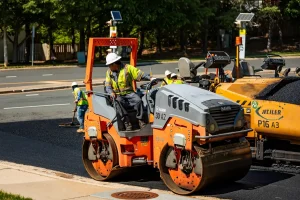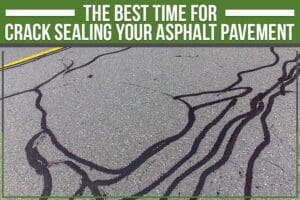Key Takeaways:
- Asphalt pavement that is subject to vehicular shear stress, improper design, and poor maintenance can result in cracks.
- These cracks can allow water intrusion, leading to repeated freeze-thaw cycles that exacerbate the asphalt’s functionality, integrity & aesthetics.
- Alligatoring & potholes can result from excess water intrusion from unsealed asphalt cracks. Too much moisture in the pavement’s layers can lead to subsidence.
- Cracked asphalt is unaesthetic and gradually loses function & durability – hence the importance of asphalt maintenance.
- Schedule asphalt maintenance & crack sealing in the fall & spring seasons. Winter and hot summers can complicate crack seal curing.
- It is always advisable to hire an adept paving contractor like Brothers Paving & Concrete to deliver high quality results on the first try. Secure a free quote today!
Cracks in asphalt pavement, no matter how small or big, are unsightly and pose a risk to drivers and pedestrians alike. It is best to resolve the issue quickly before further deterioration occurs. That is also a significant reason why asphalt maintenance is a routine to be reckoned with.
Brothers Paving & Concrete are expert paving contractors, offering top-notch services in all things related to asphalt, from installation and repair to crack sealing. But let’s begin with the deal behind caring for paved asphalt surfaces.
Why Is Asphalt Maintenance Important?
Asphalt maintenance is essential because it helps extend the pavement’s lifespan, improves its appearance, and enhances its safety and functionality. Regular maintenance activities such as filling cracks, patching potholes, and resealing surfaces can prevent damage from spreading and costly repairs in the future.
It also helps maintain the integrity of the pavement and prevents water and other elements from penetrating and causing further damage. Overall, asphalt maintenance helps ensure that the pavement continues to perform optimally and provides a safe and smooth driving surface.
Maintenance begins with inspecting your pavement for signs of damage, especially cracks, as they indicate stages of pavement failure. You might have to consider a few more factors, but we have listed a few for you below.
Related: The Importance of a Pavement Maintenance Plan
Signs Your Pavement Needs Crack Sealing
1. Cracks: Visible cracks on the asphalt surface clearly indicate that it’s time for a crack seal.
2. Aging: Over time, asphalt naturally deteriorates and cracks. If your pavement is more than 20 years old, it’s likely to need sealing.
3. Potholes: They can form when water seeps into cracks in the asphalt and freezes, causing the surrounding material to expand and create a hole.
4. Raveling: This is when the aggregate (small rocks) in the asphalt surface becomes loose and starts to break apart, creating a rough and uneven surface.
5. Alligator cracking: This is a pattern of cracks that resemble an alligator’s skin, and it’s a sign that the underlying structure of the asphalt is failing.
6. Deformation: If the surface of your pavement is sagging or deforming, it’s a sign that the base layers have become unstable and need to be repaired.
Crack sealing is important to prevent further damage and extend the life of your asphalt pavement.
What Is the Best Time to Crack Seal Asphalt?
An effective maintenance program requires diligence and the services of a reputable and experienced asphalt contractor who fully understands the essential procedures for pavement upkeep. However, there is one step that should never be overlooked in sealing cracks, and that is the time of the year.
The best time to crack seal asphalt is during the spring or fall months when the weather is mild, and temperatures are between 40-85°F. These values are not to be confused with the application temperatures that are 40-400F for hot pour crack fill & 50-120F for cold pour. This temperature range allows the crack filler material to adhere properly to the pavement surface and cure. The rubberized molten sealer then goes over the filled crack to form a seal.
Sealing cracks during the summer with high temperatures can cause the material to dry prematurely and crack. Sealing during the winter when temperatures are low can cause the material to freeze and not bond properly. By sealing cracks during the spring or fall, you can ensure that the repair is effective and long-lasting.
Further Benefits of Crack Sealing Asphalt
1. Prevents further damage: Cracks in asphalt pavement can allow water and other elements to penetrate the surface, causing further damage to the underlying structure and eventually leading to potholes and other serious problems.
2. Extends the pavement’s life: By sealing cracks, you can prevent water and other elements from penetrating the surface and causing damage, which can extend the life of the pavement.
3. Improves safety: Cracks and other imperfections in the asphalt’s surface can be dangerous for drivers, cyclists, and pedestrians, as they can cause vehicles to lose traction or trip hazards for people walking on the pavement.
4. Maintains appearance: A well-maintained asphalt pavement with no visible cracks or other imperfections can enhance the appearance of a property and add to its value.
5. Reduces maintenance costs: Regular maintenance, including crack sealing, can help prevent more severe and costly repairs. By sealing cracks promptly, you can reduce the need for more extensive repairs or even a full paving job.

Unsealed Asphalt Cracks Invite Water Intrusion Damage
Many people are surprised to learn that water is one of the most dangerous enemies of asphalt pavement. Water can enter through open cracks, whether the source is rain, melting ice, or snow. It then seeps into the various layers that make up the pavement foundation, subgrade, and aggregates – and then the freeze-thaw process starts. Repeated cycles can result in further active cracks, alligatoring, and potholes. Moisture-affected soils can also result in gradual pavement subsidence, leading to punchouts.
Is It Wise to Crack Seal Asphalt in Cold Weather?
A crack seal during winter can be challenging due to low temperatures and the potential for precipitation. Low temperatures can cause the crack filler material to freeze before it can properly adhere to the pavement surface, reducing the effectiveness of the repair. Snow and ice can also prevent the material from bonding properly and hinder curing.
If crack sealing is necessary during winter, it is essential to take extra precautions to ensure that the repair is performed under optimal conditions. That includes using professional equipment such as a hot air gun to warm the surface to at least 40F before application or a crack filler specifically designed for low-temperature application.
It is recommended to enlist the services of a professional asphalt paving contractor for a crack seal because they are experienced with the job. It is also optimal to have the pavement’s cracks tended to in the fall or spring when temperatures are mild and there is less potential for precipitation.
Related – Cold Weather & Its Effects on Your Asphalt Pavement
Get Your Pavement Sealed Against Damage This Spring!
If you’re in the market for a crack sealing job on your asphalt pavement, consider availing the services of the expert paving contractors Brothers Paving & Concrete, serving DC, Maryland & Virginia. Our services include crack sealing, asphalt paving, installation, and repair. We use premium DOT-certified materials and offer round-the-clock customer support.





